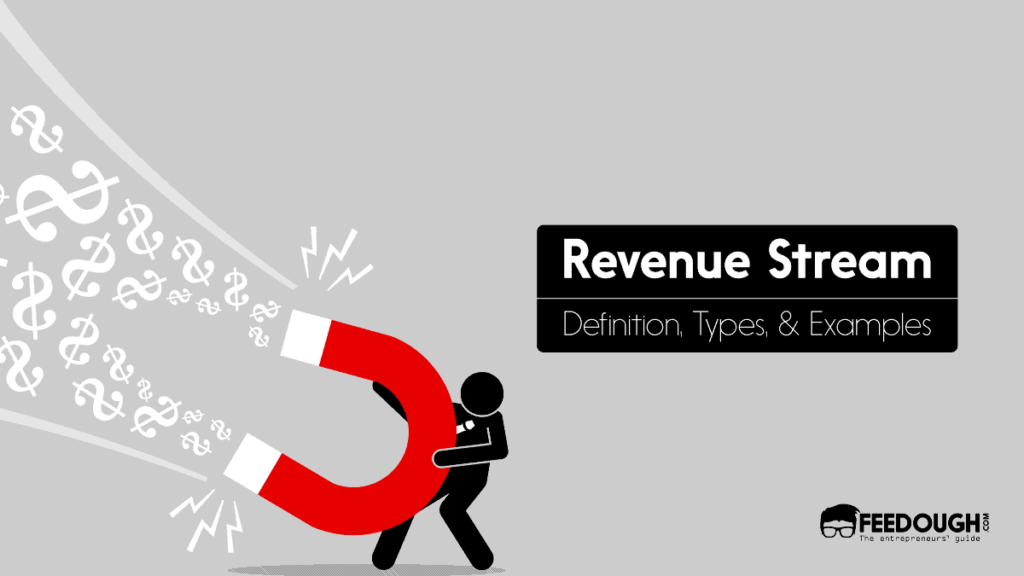Businesses tend to have several sources of revenue. Take Apple Inc., for example; the company generates its revenue from iPhones, iPads, MacBooks and other devices while also offering services like Apple TV+ and Apple Music. These sources of revenue are revenue streams of Apple.
Businesses prefer to have more than one revenue stream as depending on just one revenue source may prove risky.
But what exactly is a revenue stream? And what are the types of revenue streams that a business can opt?
Let us find out!
What is Revenue Stream?
Revenue streams are the different sources through which a business earns its revenue.
A business takes into account all the different activities it performs in the market to generate revenue. These various sources of revenue are its revenue streams.
Types of revenue streams
Generally, revenue streams are categorised into two types – operating and non-operating revenue.
Operating Revenue
Operating revenue is the revenue that a business earns from its core business activities. For example, a bakery would earn its operating revenue by selling cakes and other food items it sells.
The revenue earned through such sources is sales revenue or service revenue.
Here are some of the ways through which a business generates operating revenue:
- Transaction-based revenue: The revenue generated through a one-time payment made by a customer on the purchase of goods. For example, if a furniture store sells a chair to a customer, it’s a transaction-based revenue.
- Usage fee or Service Revenue: Here, a business provides its customer with a particular service. For example, a lodging service; the customer pays for each additional night that they opt to keep a room occupied.
- Project Revenue: Some businesses earn their revenue by taking up small-scale or large-scale projects. For example, a construction business that makes revenue for every project it signs for.
- Recurring Revenue: It’s the revenue generated by businesses through on-going payments made by customers. Examples include streaming services like Netflix, satellite television service providers etc. Recurring revenue is also prevalent in businesses whose core activities include renting, lending assets, brokering, advertising and licensing content to third parties, etc.
Non-operating Revenue
Non-operating revenue is any revenue generated from sources other than the business’ core activities. It includes the income derived from the gains or losses from a business’ investments or through other non-core sources.
- Interest Revenue: It includes the income generated through investments of a business.
- Dividend revenue: Businesses also earn dividends by holding stocks of other companies.
- Rent revenue: Renting out space, buildings, and equipment may allow a company to generate non-operating revenue.
Examples of revenue streams
- Revenue streams of Apple Inc:
- iPhone
- Mac
- iPad
- Wearables, home and accessories
- Services like Apple TV+, Apple Music, App Store, etc.
- Revenue streams of Microsoft:
- More personal computing: Windows operating system, Surface device, and gaming products.
- Intelligent cloud: Microsoft Azure, SQL Server, Windows Server, GitHub, Enterprise Services, etc.
- Productivity and business processes: Microsoft’s Office, Microsoft Dynamics and LinkedIn
- Revenue streams of Philips:
- Healthcare: imaging systems, healthcare informatics, etc.
- Consumer lifestyle: domestic appliances, personal care, etc.
- Lighting: road lighting, office lighting, decorative lighting, etc.
Importance of revenue streams
In a business, the knowledge of revenue streams:
- Helps estimate sales: Helps understand the nature of the revenue, and hence, their predictability. It further allows the business to estimate sales and income earned through a stream.
- Helps understand how the revenue generation source is performing: Analysing a revenue generation source may provide the business with valuable insight into how a revenue stream is performing and whether the stream is profitable for the business. Here, it is integral to analyse its pricing and projected life cycle as well thoroughly.
- Helps understand whether or not a business can achieve its objectives: Revenue is doubtlessly the key performance indicator (KPI) of a business. A KPI is essentially a value that shows how effectively a company has achieved its key business objectives.
- Helps prepare strategies: Revenue streams allow businesses to analyse their revenues and accordingly prepare strategies to ensure growth in revenues generated.
- Helps track unusual movements and trends: Analysing revenue streams allows financial analysts to figure out patterns witnessed in cash inflows. It further enables them to note unusual movements and changes in the trends of revenues and identify the causes behind the same.
- Helps an analyst develop different forecasting models: To extract the necessary information, a financial analyst is required to develop different forecasting models for different revenue streams. For example, a forecast model for a recurring revenue would have a uniform structure, whereas for a project revenue, the analyst would have to continuously modify the model depending on the project’s situation (would have to take into account the risk-factors, project renewal, etc.).
Go On, Tell Us What You Think!
Did we miss something? Come on! Tell us what you think about our article in the comments section.
A startup enthusiast who enjoys reading about successful entrepreneurs and writing about topics that involve the study of different markets.








